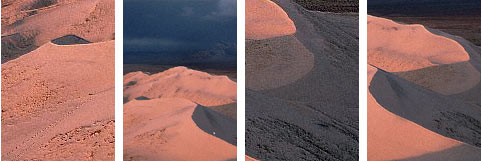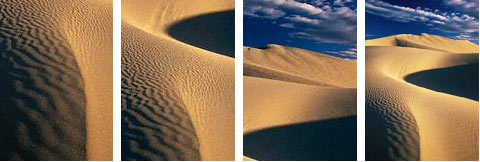


Exceptionally smooth, well-rounded quartz sand comprised of similarly sized grains (sand does not have to be on a steep surface such as a dune) Surface sand should be hot and dry (wet sand can sometimes work, too, but neither wet nor dry sand should be tightly packed if sand is to produce noise because packed sand cannot easily be displaced) A foot, hand, or stick with which to step on, sweep, or poke the sand (one could also collect the sand in a container and shake) 
A sand dune, preferably one that has recently undergone a strong, avalanche-producing sandstorm and has not yet stabilized A large volume of uncommonly smooth sand with virtually no protrusions on the grain surfaces Sand grains that are very round and dry (moisture on the dune's surface can cause sand to clump together, inhibiting avalanching) Grains on the dune's surface that are "well sorted," meaning they are all similar in size A band of hard-packed sand grains below the surface made wet from percolating rainwater An avalanche, natural or manmade Wind, preferably moving at 14 mph or more A warm, dry climate (Killpecker Dunes in Wyoming or the Great Sand Dunes in Colorado, two usually cool climates, can work in a pinch) |
When he heard them in the Gobi Desert, Marco Polo believed they were spirit voices. Ancient Chinese literature describes ritual celebrations of their divine power. In 1941, after crossing the Sahara, British engineer and explorer R. A. Bagnold was captivated by their spell. The "weird chorus" of sound-emitting desert sands was, he wrote, "the song of sirens who lure travelers to a waterless doom, the toiling of underground bells in sand-engulfed monasteries." After generations of mystical interpretations, researchers are finally closing in on a scientific explanation for the acoustics of sand. They now agree that the phenomenon of noisemaking sand is made possible by the action of displacement, which produces musical instrument-like vibrations in sand grains. The exact recipe for noisy sands is still only wholly known in Mother Nature's kitchen, but here are the necessary ingredients and right conditions experts have deduced so far for the two main varieties. Sands that Croak, Whistle, Squeak, Bark, Burp, etc.
Listen to croaking sand Unlike the haunting so-called booming sands that Marco Polo and others discovered among the isolated dunes of storied deserts, the noises sand makes are not always mellifluous. Some relatively ordinary beach sands on the shores of oceans, lakes, and rivers make mundane noises. Generally called squeaking sands, these common cousins of booming sands work like this: By stepping on a stretch of beach or dune, moving across it with your hand, or poking it with a stick, pencil, or other such object, you can, given the right kind of sand (see ingredient list at left), produce peals of sound at very high frequencies—between 500 and 2,500 hertz—lasting less than a quarter of a second. These bursts result from the friction produced when the pressure of applied weight causes surface sand to displace and rapidly rub against the surrounding sand. The kind of sound produced depends on the texture and size of the sand grains. Sands That Go Boom
Listen to booming sand Only around 30 "booming" dunes are known worldwide—in deserts and on beaches in Hawaii, North and South America, Africa, the Middle East, and Asia. The sounds of booming dunes have been compared to a variety of instruments, including violins, cellos, trumpets, bells, organs, and didgeridoos, which are Australian aboriginal wind instruments. Booming sand dunes sound like instruments because, as opposed to squeaking sands, the noise they produce lasts longer (up to 15 minutes in large dunes) and it emanates at a single, steady musical tone. How all the factors that produce booming sands mingle to affect the nature of their song is still a mystery, but here is what's known: Booming sand starts with a dune made of sand that has traveled long distances from its original source. The sand's lengthy, windy journey means that grains deposited on the surface of the dune are extremely round, smooth, and uniform. Next, a desert rainstorm must take place, washing dust and other foreign particles from among the surface grains. The topmost sand must then dry out over a period of weeks while the sand beneath remains relatively moist. In squeaking sand, noise-producing displacement can occur merely by stepping on the sand with your foot. Booming sand requires the shearing action of a sand avalanche. Avalanches can begin only after a dry desert sand dune has built up to an angle of about 35 degrees and only when a sufficient amount of wind provides enough force to begin the avalanche. During an avalanche, surface layers of dry sand slip over the lower layers of the dune. Individual grains of loose surface sand bounce up and down over the compacted lower layers of the dune, which have a higher moisture content. The interaction between the upper- and lower-layer sand grains produces vibrations that make sound, much as a violin string does as a bow passes over it. Booming sand makes loud, low-frequency sounds of 50 to 300 hertz. During a large avalanche, the booming can be heard more than six miles away and standing near its locus can be deafening.—Lexi Krock Photos: (top sand dunes) © WGBH/NOVA; (bottom sand dunes) © Corbis Images |
||||||||||
|
|
|||||||||||
|
© | Created January 2005 |
|||||||||||